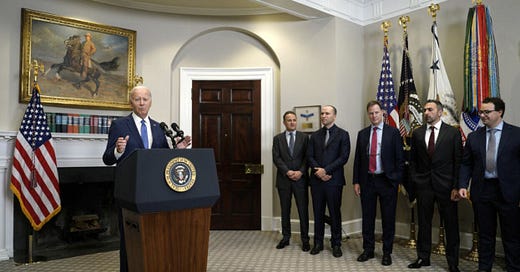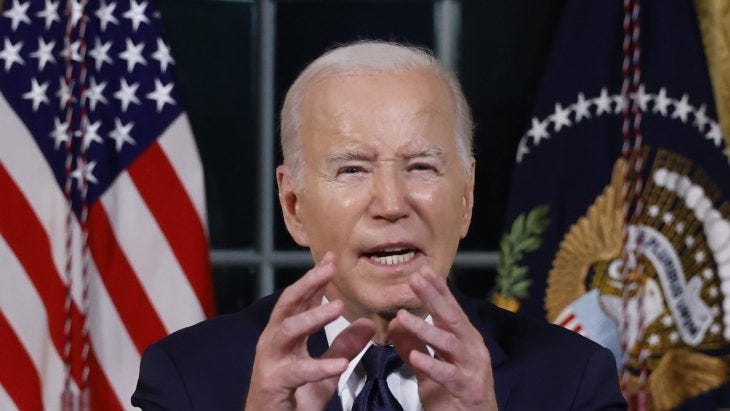Biden's Landmark Executive Order on AI: A Template for Global Governance?
U.S. President Today Signed a Crucial Executive Order on Artificial Intelligence.
Executive Order Signed
U.S. President Joe Biden today signed an Executive Order, marking a pivotal moment in the governance and ethical use of artificial intelligence (AI) within federal agencies and beyond. Building upon voluntary commitments from 15 major technology firms earlier this September, this landmark directive aims to facilitate the seamless integration of AI technologies across diverse sectors while also establishing rigorous safety and ethical guidelines. Under the earlier White House pledge, prominent companies such as Google, Amazon, Microsoft, Meta, Nvidia, and ChatGPT-maker OpenAI committed to independent security assessments of their systems prior to public release and agreed to share safety data with both the government and academia.
Setting the Stage for AI Governance
The much-anticipated executive order serves to confront the legal and ethical challenges associated with AI. Although Congress and law enforcement agencies have been probing into AI-related concerns, this directive instantly provides a legal framework. A senior administration official underscored that the order carries "the force of law." White House Deputy Chief of Staff Bruce Reed described the order as "the most robust set of measures any government globally has ever instituted on AI safety, security, and trust."
Eight Pillars of the Executive Order
The executive order encompasses eight key components:
Safety and Security Standards: It mandates that certain AI companies share safety test results with the federal government and instructs the Commerce Department to offer guidance on AI watermarking.
Consumer Privacy: The order lays down guidelines for evaluating privacy techniques employed in AI technologies.
Equity and Civil Rights: It provides guidance to landlords and federal contractors to avoid discrimination exacerbated by AI algorithms.
Justice System: Best practices are to be developed concerning AI's role in risk assessments, sentencing, and crime forecasting.
Consumer Protection: The Department of Health and Human Services will evaluate potentially harmful AI-related healthcare practices.
Labour Market Impact: A report will be produced to study the potential implications of AI on the labour market and strategies for workforce support.
Innovation and Competition: The order includes an expansion of grants for AI research and eases immigration criteria for highly skilled workers in AI.
Global Collaboration: The U.S. will work with international partners to implement global AI standards.
Timeframes and Next Steps
The Biden administration expects rapid progress, with aggressive timing laid out for some safety and security aspects. While some initiatives could see implementation within 90 days, others might take closer to a year.
Unresolved Concerns
Although the executive order is a significant step, it does not eliminate all concerns related to AI, such as toxic speech and racial bias. It, however, opens up a framework for ongoing development and legislation.
Why This Matters for the World
The timing of this executive order is critical, particularly as the United Kingdom is on the brink of hosting an international conference focused on AI governance, and the European Union is in the process of finalising its guidelines on the subject. Governments and regulatory bodies worldwide have grappled with the pace at which technology evolves, often outstripping the ability to legislate or impose meaningful governance. The White House has thus made a strategic move by introducing this comprehensive framework, which may well serve as a template for other nations.
Balancing Innovation and Regulation
It's no secret that technology often outpaces regulation. Regulatory agencies around the globe, including those in India, have struggled to catch up with the rapid advancements in AI. The challenge lies in crafting policies that safeguard ethical and safety considerations without hampering creativity or the efficient use of technology. The U.S. seems to have struck a balance by promoting innovation, ensuring worker rights, protecting consumer privacy, and advancing civil rights, all encapsulated in the eight pillars of the executive order.
International Convergence and Divergence
While the U.S.' approach could influence international guidelines, it's worth noting that entities like the European Union may opt for divergent pathways. For instance, considerations around data privacy and antitrust measures could see the EU taking a different stance. Nevertheless, easing immigration rules for highly-skilled AI experts, as mentioned in the executive order, could become a universally appealing strategy to meet the demands of this burgeoning field.
The Road Ahead
As the AI industry continues to expand at an accelerated pace, this executive order offers a structured framework for risk assessment, thereby encouraging responsible usage and development of AI technologies. This not only cements the U.S.'s position as a leader in establishing safety and ethical standards in the AI domain but also serves as an invaluable tool for both domestic governance and as a reference for global best practices in AI management. While this initial framework is likely to undergo refinements in the coming months and years, it currently stands as a robust blueprint that other nations might consider emulating or adapting to suit their specific needs in the complex landscape of AI regulation.
Lesson for India
In the Indian context, it's crucial for techno-bureaucrats to rigorously examine the U.S. executive order and offer expert advice to senior political leadership on the feasibility of issuing a similar directive through an executive notification or opting for a more comprehensive statutory framework. Considering the swift evolution of AI technology and India's imperative to keep pace, it's urgent to arrive at these decisions, incorporating any necessary local adaptations, without further delay.






